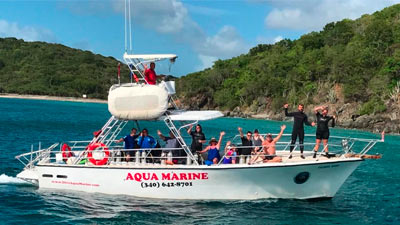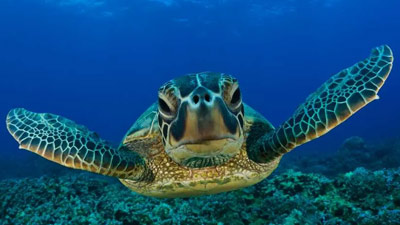St. Thomas dive shops offer a variety of options for all divers, from beginner to advanced. In this article, we share some of the best dive shops on St. Thomas, the dive options they offer, the dive conditions in the Virgin Islands, and popular dive sites around St. Thomas.
Let’s start with St. Thomas scuba diving options. If you are new to scuba, you can take an introductory dive class to try it out, or take the Scuba Diver Course to get certified. For children age 8 and older, there is a bubble-maker course. It allows kids to experience diving in a supervised environment. Certified divers can enjoy boat dives, beach dives, night dives, and wreck dives. Dive shops on St. Thomas offer advanced certification courses, including Open Water, Rescue, and Divemaster. Contact a St. Thomas dive shop for more information.
“Expect the Unexpected” with this charming family friendly boutique dive and charter operator. It is one of the newest in St. Thomas and gaining popularity with their outstanding customer service and flexibility. The Island Adventure Charter with Lobster BBQ is one of many customizable charters available with JJ Divers, please call today to book your adventure with this 5 star google award winner.
Aqua Marine Dive Center

For over a decade, Aqua Marine has offered exceptional diving and snorkeling experiences in St. Thomas with a reputation for small group tours and personal attention. With 40 different sites to choose from, including colorful reefs, shipwrecks, pinnacles, and walls, it’s easy to avoid the crowds and see an abundance of marine life. No certification? No problem! Test the waters with Discover Scuba Diving. Aqua Marine also offers dive certifications (PADI/SSI/SDI) and private charters. No matter the activity, Aqua Marine’s owners and crew are passionate about helping each guest discover the wonders of the underwater world and inspire a love for the ocean.
Water activitySt. Thomas Scuba Diving
There are many dive sites around St. Thomas. You can dive among corals and gorgonian forests, swim through remarkable natural tunnels and around ledges, and explore wrecks. Take a night dive and visit the fantastic world of nocturnal marine life. See turtles, bright parrotfish, sharks, eagle rays, and so much more. Scuba diving in St. Thomas is available year-round; however, there are annual weather seasons that can negatively affect dive conditions. These include the rainy months between September and November and hurricane season, which is from June to November. The most active months of hurricane season are August and September. Visibility is generally between 60 and 100 feet. St. Thomas and St. John sit on a shallow ocean plateau, which results in diving depths up to around 80 feet. Dive sites around St. Thomas include beach dives, reef dives, and wreck dives. Most of the dives are just a short boat ride from shore, about 15 to 45 minutes. Let’s take a look at some of the popular St. Thomas dive sites.
Popular Dives around St. Thomas
Coki Point Beach, located on the east end of St. Thomas, is usually very calm and clear. This is a beach-entry dive; therefore, no surface swimming or boat is needed. You start out with a sandy bottom and make your way to a depth of about 40 to 50 feet. Here the bottom drops gradually, and you will see a variety of coral and fish. Coki Beach is great for beginning divers, and its excellent for night dives too.
Buck Island is a small island located south of Charlotte Amalie St. Thomas. There are a few dive sites here. On the north side of Buck Island there is Andre’s Reef, which starts in shallow sand and leads to a dropoff. A variety of fish and turtles gather along the ledge. You can continue and follow the coral-covered slope to about 75 feet. You will see schools of fish and gorgonian gardens. On the west end, there is Buck Island Point. It starts around 45 feet at a nice reef. Expect fish, sharks, turtles, stingrays, and more. As you explore this site, you will find a gently sloping wall reaching to depths of around 80 feet. You might see large southern sting rays, sometimes a blacktip reef shark, plus large schools of fish.
Off the west side of Buck Island, there is the Cartanza Senora, a wreck dive. The old vessel is split in three pieces and found within Buck Island Cove. From the wreck, it’s possible to then explore Wye Reef. There are several terraces at that site that go down to 60 feet, and here you can see sponges, turtles, nurse sharks, and a variety of fish.
Cow and Calf Rocks are located about .5 miles from the shore on the south side of St. Thomas. The two rock formations are near each other but are two different dive sites. At Calf Rock, there are numerous ledges and crevices—many spaces to look around and under. In the cracks and crannies, you might find green moray eels, crabs, lobsters, and nurse sharks. There are soft corals and gorgonian gardens here. This is a great dive for photographers, as the water is clear and the depth is shallow. Cow Rock has a series of swim-throughs and arches, plus its unique ‘champagne cork’ feature. This dive site is within a protected marine preserve. Cow Rock is one of St. Thomas’s most popular dive sites for introductory and certification dives. The maximum depth is around 45 feet. There is an abundance of fish, plus soft and hard corals, lobsters, stingrays, and sharks. You might see tarpon and turtles too.
French Cap is a little island located about 6 miles south of St. Thomas. The conditions must be calm to go to this dive site, and it is recommended for divers with at least an intermediate skill level. There are a couple dive spots here, including a shallower dive to 60 feet on the northwest side. The second site has a neat swim-through. French Cap is like a small mountain rising 90 feet through the water; its covered in a variety of coral. You might see barracuda, snappers, spotted eagle rays, and turtles swimming around, plus morays and octopus hiding in the rocks. It is one of the few places you can see Black Durgeons.
Thatch Cay is a small island located off the coast of St. Thomas. There are several dives here, including Arches and Tunnels, the Cathedral, and Vetty’s Bay. Arches and Tunnels on the northwest end of the cay offer a unique dive because of the huge natural tunnels cut through the cay. Depth is around 25 to 40 feet. While the rock formations are really the main highlight, there is plenty of marine life to see. Among the swim-throughs and ledges are colorful sponges, baitfish, tarpon, angelfish, and more. This dive site is only safe when conditions are flat and calm. This dive site is suggested for those with at least an intermediate skill level.
Grass Cay, Mingo, Congo & Lovango Cays are a chain of small islands near St. Thomas. There are quite a few good dive sites in this area. Two of the most popular are at Congo Cay and Carval Rock.
Congo Cay’s eastern portion offers dramatic ridges and pinnacles with a great number of soft coral formations. The depth is 25 to 80 feet. This is best for experienced divers. On the southwest portion, there is a popular dive site for beginners and experienced divers. The depths there are 30 to 60 feet. Congo Cay’s dive sites are in close proximity to deep waters, which increases the likelihood of seeing larger marine animals like eagle rays, reef sharks, and occasionally bottlenose dolphins.
Carval Rock, which is east of Congo Cay, is another of St. Thomas’ amazing dive sites. This is due to the large variety of marine life that is consistently found here. In addition to marine life, there are cool rock formations and swim-throughs. At the deepest points, you are swimming through a canyon with almost vertical walls. Very neat. The sheer wall drops to around 80 feet. Look out for nurse sharks.
Located southwest of St. Thomas, St. James and Little St. James offer several dive sites. These include Christmas Cove, the Reefs at Stragglers, which is a neat dive site known for its unusual topography, Ray Alley, and the Ledges of Little St. James. The Ledges of Little St. James are one of the most popular with beginners through experienced divers. It is a sheltered dive site and is consistently clear and calm. There are deep ledges and overhangs filled with corals, sponges, and fish. You might see spotted eagle rays and sometimes nurse sharks.
Wreck Dives in St. Thomas
WIT Concrete is a 350-foot carrier originally done in by a hurricane. It was moved by the U.S. Army Corps of Engineers to its current location, which was suitable for an artificial reef. She sits fully upright in 100 feet of water. Encrusted with a variety of sponges and corals, you can see fish and occasionally large reef sharks at this wreck.
Miss Opportunity is a 300-foot hospital ship. She lies on her side in around 90 feet of water. She sank in 1985. The wreck is easy to explore, as it broke open when it hit the bottom. Home to huge groupers, sharks, and other marine life. This is an exciting dive for advanced divers.
Navy Barges is comprised of two barges near each other. These barges, along with three others, were sunk in the general area. They were originally U.S. Navy housing barges. They are at about a 45-foot water depth. During shark breeding season in June, it is common to see congregations of sharks under one area of the wreck.
The WIT Shoal is a 400-foot freighter, sitting upright in around 90 feet of crystal-clear water. This is a good dive site for photographers, as there is great light in the passageways. This is an advanced dive.
St. Thomas dive shops are knowledgeable about the dive sites and can safely guide you to and around them. They can also suggest dive sites that fit your interests, whether that’s underwater photography or seeing certain species of marine life. Whether you are new to scuba diving or a diving enthusiast, St. Thomas is a great place to scuba dive.
It is noteworthy to mention that there is a hyperbaric chamber available at the Schneider Regional Medical Center on St. Thomas in case of scuba diving emergencies.

